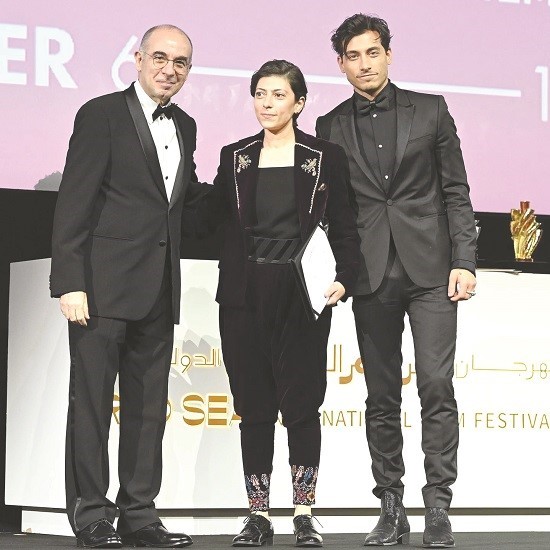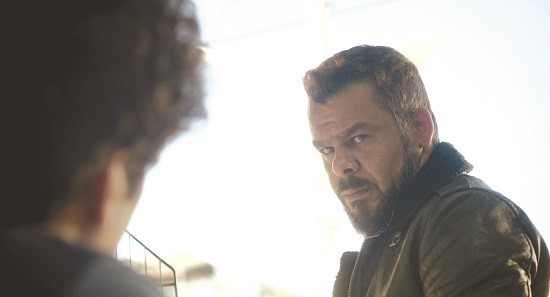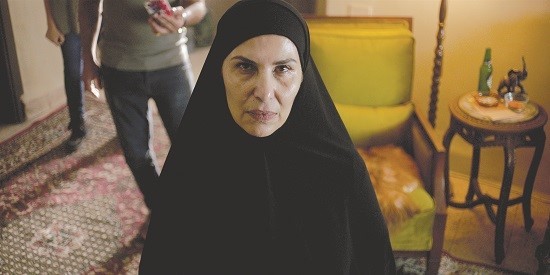JEDDAH — Jordanian cinema had a strong
presence at the first edition of the
Red Sea International Film Festival,
held in Jeddah, Saudi Arabia, showing three movies with a distinctive production
style, most inspired by true events.
اضافة اعلان
“
Farha”, “
Daughters of Abdul-Rahman”, and “
The Alleys” are perhaps the best Jordanian films made in
the past few years; two mark the debut for their directors.
 Darin Sallam receives her special mention at the Red Sea International Film Festival. (Photo: Israa Radydeh/Jordan News)
Darin Sallam receives her special mention at the Red Sea International Film Festival. (Photo: Israa Radydeh/Jordan News)
“Farha”, by
Darin J. Sallam and at
its first regional screening at the festival, is based on the true events of the
Palestinian Nakba of 1948.
Little Farha, 14 years old,
extremely devoted to her father, goes through a tortuous and rich journey to the
times of
Nakba.
Love for Palestine, the Earth, and
the eye of an innocent witness who was moved by childhood events and a storm
that toppled the dream, including family, home, and home, are all present in
the movie. It is a harrowing story in which Farha, who dreamed of completing
her studies in the city, pending the approval of her father, sees her dream
torn apart by Nakba, which also comes with the loss of the father, home,
neighbors, parents, loved ones, misfortune, a friend, memories, the taste of a fig,
and of the sun that does not lose sight of the Bayader.
 Stills from the movie Farha. (Photos: Handouts from Ayah Jardaneh)
Stills from the movie Farha. (Photos: Handouts from Ayah Jardaneh)
Facing the Israeli occupation, her
father had to go into a vault and return to her after a while. Stories can be
seen through narrow holes in the door and the wall. They are tales of pain in
an aggressive rhythm from which no one has been delivered. Tales of treason and
conspiracy, of struggle, challenges, and desire, of births and assassinations.
There are details of the time that
passes when there is nothing in that vault but vacuum and hope that the sun
that leaks from those holes will rise and give hope.
Arab actors including Ashraf Barhom,
Ali Suliman, and Sameera Asir played in the film.
 Stills from the movie Farha. (Photos: Handouts from Ayah Jardaneh)
Stills from the movie Farha. (Photos: Handouts from Ayah Jardaneh)
Karam Tahir, who played Farha, delivered
a great performance for someone who stood in front of the camera for the first
time in the tiny closed place from where she made the viewers feel her fears
and struggles before she liberated herself.
The film
proceeded from classical to modern filming, with a clever palette of colors to
highlight Farah’s sophistication in the way she views the world.
Farha got Special Mention at the festival.
Daughters of
Abdul-Rahman is a story of women’s ideological and social liberation.
Zaid Abu
Hamdan’s debut film draws attention to stereotyped characterizations of women a
community where patriarchy and machismo dominate. It is a movie about dramatic
events, comedy, and sad moments that leave the heart in pain and affected by
the characters’ transformation that follows the life of Abdul-Rahman’s four
daughters: Amal, Zainab, Tahah, and Almah. Three live away, unlike Zainab, who
lives with her father and takes care of him until he disappears one day. That
is where things get harder, and the struggle begins.
The events
of the film begin with the rapid passage of their lives and escalate from the
moment the four girls met after years of separation because of the sudden
disappearance of their father.
Zainab, the
eldest daughter, dreamed of becoming a musician; instead, she is living with
her father. Amal married at a young age, wears the niqab, and is being physically
abused by her husband, who wants to marry off their youngest daughter at the
age of 15.
Samah gets
married to a rich man, lives in shame for having a gay husband, and feels
depressed and used. The youngest sister, breaking all taboos, took off her
hijab and moved to Dubai with her boyfriend, who decides to marry her later and
comes back to get her father’s approval.
Abu Hamdan’s
film is based on deep research of social and women struggle against social
standards and violence. It raises the issue of family life, domestic violence,
and underage marriage. It raises issues of family life, customs and traditions,
and specifically the upbringing of girls in Arab societies. It also deals with
thorny issues such as gender discrimination and the wearing of the niqab.
 Stills from the movie The Alleys. (Photos: Handouts from Bassel Ghandour)
Stills from the movie The Alleys. (Photos: Handouts from Bassel Ghandour)
The Alleys
is perhaps one of the best movies, with great filming techniques,
cinematography, script, and acting. It was written and directed by
Bassel Ghandour and explores the daily life and routine in a place where everyone knows
everything about everyone.
Ali (Emad
Azmi), who is in love with Lana (Baraka Rahmani), the daughter of the local
hair salon owner (
Nadira Omran), is a hustler; their lives are turned upside down
when they confront, in the neighborhood, a local gangster,
Abbas (
Monzer Reyahnah), and right-hand woman, Hanadi (Maisa Abd Elhadi).
Plenty of twists are present in The Alleys, which is a story of dark backstreets, control, and its consequences.
The film is about trying to placate societal structures and traditions at the expense of the individual, about illegal methods to empower oneself at the expense of the many.
 Stills from the movie The Alleys. (Photos: Handouts from Bassel Ghandour)
Stills from the movie The Alleys. (Photos: Handouts from Bassel Ghandour)
Making for an entertaining thriller filled with themes and ideas, The Alleys shows how negative emotions and energies can betray one.
The film talks about conflicting emotions and antisocial natures in characters one can identify with.
Read more Entertainment



